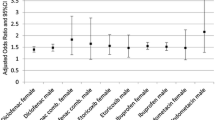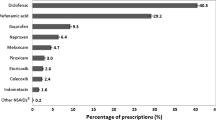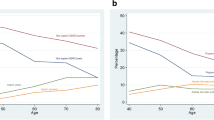Abstract
Non-steroidal anti-inflammatory drugs represent an important drug class in ambulatory care. A utilization study among half a million persons showed that 8.6% could be identified as having used one or more non-steroidal anti-inflammatory drugs (excluding salicylates) in 1987. Data were drawn from a representative sample of pharmacy records which comprise full medication histories of individual patients. Overall utilization of non-steroidal antiinflammatory drugs was 10.8 defined daily doses/(1000 persons · day). Approximately three quarters of the patients are ‘incidental’ users and receive non-steroidal anti-inflammatory drugs for a relatively short time (30 days or less). Patients who were identified as ‘regular’ (31–210 days of therapy) and ‘heavy’ (>210 days of therapy) users, accounted for 21.2% respectively 4.8% of all users. ‘Heavy’ users are responsible for 17.3% of all non-steroidal anti-inflammatory drug prescriptions. Especially the elderly and females are prone to be ‘heavy’ users. Five drugs account for 90.4% of all prescriptions (diclofenac, ibuprofen, naproxen, piroxicam, indometacin). A total of 71.1% of the patients with more than one prescription for non-steroidal anti-inflammatory drugs switched in therapy. There are two classes of concomitant drug use especially relevant with respect to detecting non-steroidal anti-inflammatory drugs-associated risks: H2 blockers and antacids (belonging to anatomical therapeutic and chemical anatomic class A) and diuretics (belonging to anatomical therapeutical chemcial anatomic class C). More than half of the ‘heavy’ users showed concomitant use of drugs in these classes.
Similar content being viewed by others
References
Baum C, Kennedy DL, Forbes MB. Utilization of non-steroidal anti-inflammatory drugs. Arthr Rheum 1985;28:686–92.
Steele K, Mills KA, Gilliland AEW, Irwin WG, Taggart A. Repeat prescribing of non-steroidal antiinflammatory drugs excluding aspirin: how careful are we? Br Med J 1987;295:962–4.
Bergman U, Dahlstrom M, Sanz EJ. Use of non-steroidal anti-inflammatory drugs and other minor analgesics in Sweden. Proceedings of the workshop ‘Pharmacotherapy in osteoarthritis’. Uppsala: Drug Information Committee, National Board of Health and Welfare, 1989:2.
Urquhart J. Two cheers for NSAIDs. Gut 1986;27:1287–91.
Weber JPC. Epidemiology of adverse reactions to nonsteroidal anti-inflammatory drugs. Adv Inflam Res 1984;6:1–15.
Committee on Safety of Medicines. Non-steroidal antiinflammatory drugs and serious gastro-intestinal adverse reactions. Br Med J 1986;292:614–6.
Guess HA, West R, Strand LM, et al. Fatal upper gastrointestinal hemorrhage or perforation among users and nonusers of NSAID in Saskatchewan, Canada 1983. J Clin Epidemiol 1988;41:35–45.
Carson JL, Strom BL, Soper KA, West SL, Morse ML. The association of non-steroidal anti-inflammatory drugs with upper gastrointestinal tract bleeding. Arch Intern Med 1987;147:85–8.
Blackshear JL, Napier JS. Renal complications of nonsteroidal anti-inflammatory drugs: identification and monitoring of those risk. Semin Arthr Rheum 1985;14:163–75.
Van den Ouweland FA, Gribnau FWJ, Meyboom RHB. Congestive heart failure due to anti-inflammatory drugs in the elderly. Age Ageing 1988;17:8–16.
De Smet PAGM. The Dutch approach to computerized drug information. J Soc Adm Pharm 1988;5:49–58.
Isacson D, Smedby B. Defining heavy use of prescription drugs. Med Care 1988.
Rothman KJ. Modern epidemiology. Boston: Little, Brown and Company, 1986.
SAS/STAT Guide for personal computers. Cary: SAS Institute, 1985.
Arnold M, Schrieber L, Brooks P. Immunosuppresive drugs and corticosteroids in the treatment of rheumatoid arthritis. Drugs 1988;36:340–63.
Nordic Council on Medicines. Nordic statistics on medicines 1984–1986. Uppsala: Nordic Council on Medicines, 1988.
Hekster YA, Stuart CJAM, Leufkens HGM, et al. Epidemiologie van het gebruik van analgetica [Epidemiology of the use of analgesics]. J Drug Ther Res 1988;13:44–8.
Anoniem. Svensk låkemedelsstatistik 1988 [Swedish statistics on medicines]. Stockholm: Apoteksbolaget, 1989.
Jick SS, Walker AM, Perera DR, Jick H. Non-steroidal anti-inflammatory drugs and hospital admission for perforated peptic ulcer. Lancet 1987;2:38–2.
Author information
Authors and Affiliations
Rights and permissions
About this article
Cite this article
Leufkens, H.G., Ameling, C.B., Hekster, Y.A. et al. Utilization patterns of non-steroidal anti-inflammatory drugs in an open Dutch population. Pharmaceutisch Weekblad Scientific Edition 12, 97–103 (1990). https://doi.org/10.1007/BF01967602
Accepted:
Issue Date:
DOI: https://doi.org/10.1007/BF01967602




